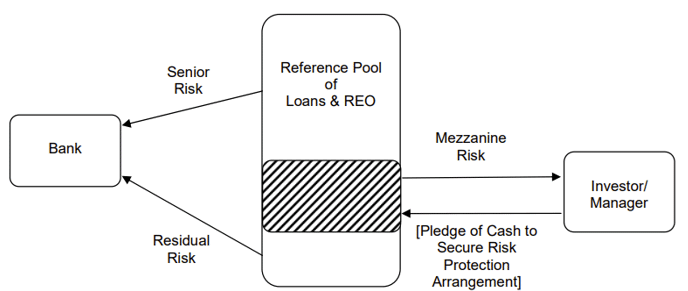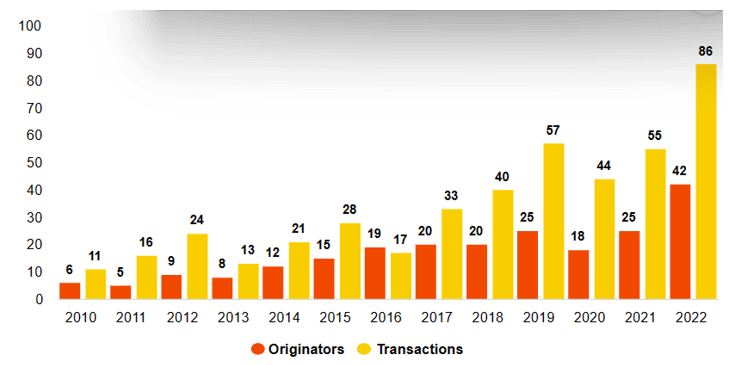
Grappling with high interest rates and related balance-sheet management issues, U.S. banks are eyeing deals that transfer their credit risk while keeping loans on their books along with the borrower relationships.
Several banks in the U.S. have entered into these synthetic risk transfers (SRTs), which are typically unrated. Such transactions are known as significant risk transfers in Europe, where they have been more routinely used, mainly to transfer risks on commercial real estate loans to alternative credit funds.
JPMorgan completed several private deals last year as U.S. regulators mulled changes to regulatory capital requirements. Last September, a Frequently Asked Questions document clarified how the Federal Reserve Board would treat credit-linked notes (CLNs), a type of SRT, issued directly by banks rather than through a special purpose vehicle (SPV) trust, the more traditional route.
Later in 2023, the central bank approved favorable capital treatment for four banks to directly issue CLNs under specific conditions, although none has acted so far. Letters from the Fed referenced auto loan SRTs for U.S Bank, Santander Bank and Huntington National Bank. Morgan Stanley, like those banks, was given a $20 million cap, but its approval did not specify auto loans.
A similar approval was granted in March to Truist Financial Corp. for a CLN transaction by its Truist Bank subsidiary.

Synthetic risk transfer diagram (source: Mayer Brown)
Europeans Out Front
SRTs are more common in Europe, where regulators were earlier to adopt Basel capital rules that are still in progress in the U.S. As proposed, the so-called Basel III Endgame’s tougher capital requirements for the biggest banks reportedly prompted JPMorgan Chase & Co.’s private SRTs last year, with more under consideration. Persistently high interest rates could encourage some banks to pursue SRTs before knowing if the capital proposals will be revised.
In February, Moody’s Investors Service and S&P Global Ratings had issued reports anticipating more SRTs in the U.S., with S&P noting the importance of the Fed’s clarifying “the capital treatment of certain SRT structures.”
The transactions “are generally economic for the issuer and accretive to its shareholder returns when the cost of the regulatory capital saving (the credit protection premiums paid to investors and other transaction expenses) is below the cost of capital,” according to the S&P report.
Separate Huntington Deal
Last December, Columbus, Ohio-based Huntington Bank pursued a more traditional SRT in which it transferred the cash flow and credit risk of auto loans to Bayview Asset Management via a bespoke credit default swap. Bayview, in turn, issued in April a $346 million CLN referencing $2.8 billion of Huntington loans.
In a pre-sale report, Moody’s noted several deal-structure elements protecting Bayview investors from losses that are not present in the directly-issued deals. “As a result of these features, unlike other bank-issued CLN transactions where we limit the note ratings at the bank’s rating, we did not limit the note ratings at HNB’s long-term senior unsecured rating (A3),” the report said.

Synthetic risk transfer originators and transactions. Source: BlackRock (Citigroup data)
European banks seeking to bolster capital ratios have preferred transferring the credit risk of corporate or other risky and highly bespoke loans, negotiating the SRTs with one or a few highly specialized alternative credit funds.
By contrast, the approved U.S. bank CLNs and the Bayview transaction aim to transfer to investors the credit risk of prime auto loans. Those referenced by Bayview, for example, have an average percentage rate of 5.55%, compared to well above 6.5% in most states.
“From an investor standpoint, we get access to core bank lending products that aren’t otherwise accessible to us,” Alan Shaffran, senior portfolio manager and head of the London office of Evanston, Illinois-based based Magnetar, which has invested in SRTs since 2008.
Anticipated Growth
The Moody’s report lists SRTs completed by JPMorgan and Western Alliance Bank in 2021 and 2022 that referenced residential mortgage loans, and sources pointed to those and other performing loans, such as student loans, as likely reference assets for future U.S. SRTs.
Robert Bradbury, head of structured credit execution at Alvarez & Marsal in London, said regional banks in the U.S. are currently wary of the still relatively new structured transactions. But he expects “more issuance from banks that have already done SRTs, and we should see more banks of Huntington’s size and smaller, but only when they have a sufficiently sizable, high-quality and granular asset base.”
U.S. deals are also starting to attract large asset managers who are interested in bank assets they perceive as carrying relatively little risk, Bradbury said, adding that these managers will expect offerings regularly, and that deals should pick up from September onwards.
Matthew Bisanz, a partner in Mayer Brown's Financial Services Regulatory & Enforcement practice, said large banks may hold off until Basel III is finalized, while smaller institutions may act sooner to transfer the credit risk of less desirable assets. “There is no reason for them to wait,” he said.
Matthew Bisanz
S&P’s report said that Barclays was exploring U.S. credit card SRTs, but those loans are complicated by the fact that they don’t have conventional maturities and frequently change in size.
“How does a bank structure the terms of investor payments when it doesn’t know what the payment cash flow will be?” Bizanz said, adding that card-loan credits would have to be high-quality and performing.
Risks to Banks and Investors
While SRTs can be effective risk management tools, if a deal’s credit risk is mispriced, it can result in asset losses exceeding what the SRT covers, Bisanz said. Or a bank may be tempted to be too aggressive in pricing SRTs referencing quality assets, prompting investors to decline the notes and leaving the bank stuck with risk it had anticipated removing.
“Currently, banks are putting a lot of pricing pressure on investors, but if you put on too much now, when you need the protection investors won’t give it,” Bisanz explained.
Investors, on the other hand, must recognize that they have synthetic exposures and no right to the assets, and that the notes are not liquid in the near term.
“These are very bespoke instruments, and you’re really either committed to selling them right away or holding them,” Bisanz said. “These aren’t investments you can decide to sell off to make your year-end numbers.”